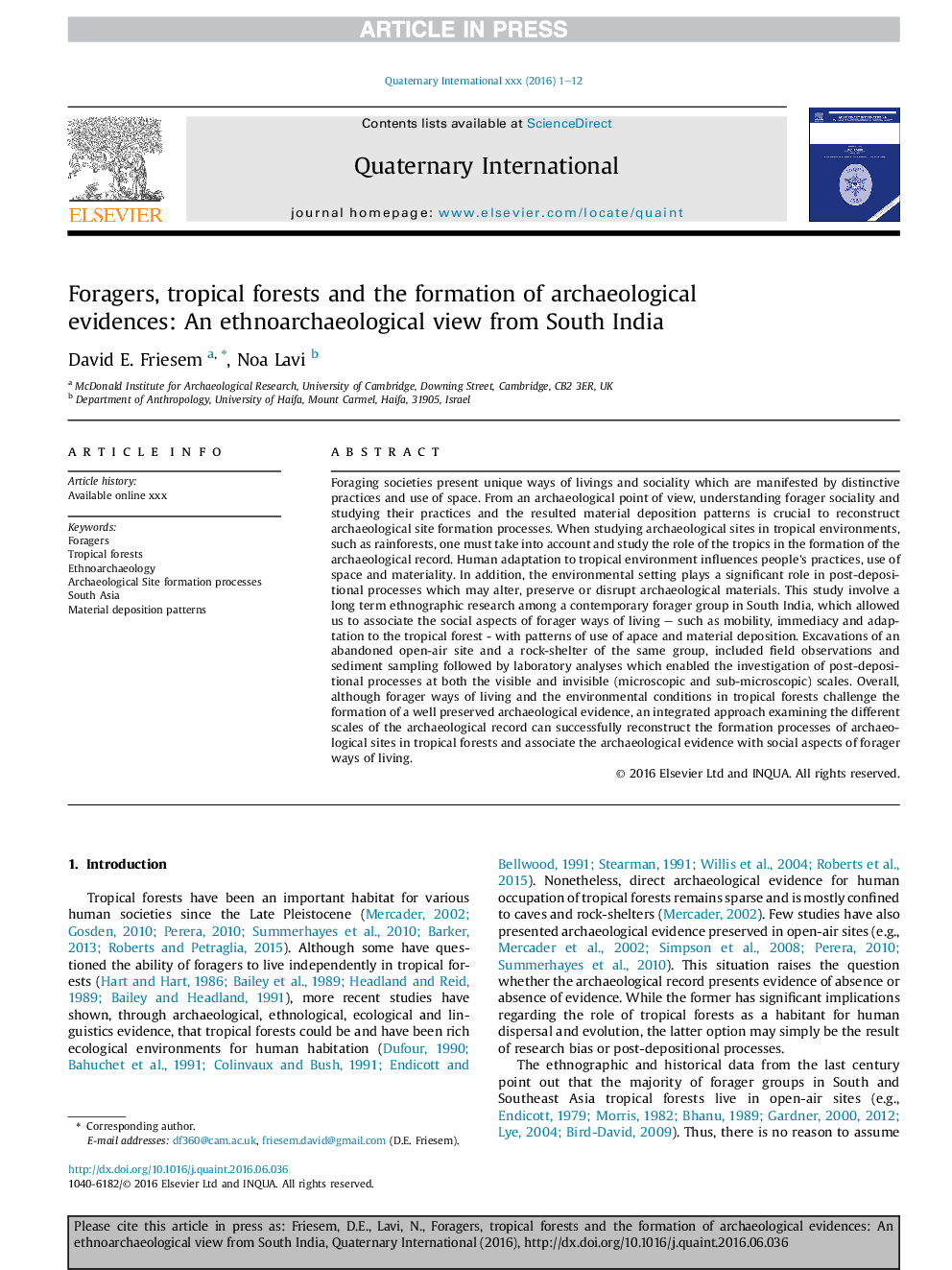| کد مقاله | کد نشریه | سال انتشار | مقاله انگلیسی | نسخه تمام متن |
|---|---|---|---|---|
| 5113036 | 1484075 | 2017 | 12 صفحه PDF | دانلود رایگان |
عنوان انگلیسی مقاله ISI
Foragers, tropical forests and the formation of archaeological evidences: An ethnoarchaeological view from South India
ترجمه فارسی عنوان
فیدرها، جنگل های گرمسیری و شکل گیری مدارک باستان شناسی: دیدگاه قومی و تاریخی از جنوب هند
دانلود مقاله + سفارش ترجمه
دانلود مقاله ISI انگلیسی
رایگان برای ایرانیان
کلمات کلیدی
فیدرها جنگل های گرمسیری، اخلاق علمی، فرآیند تشکیل پایگاه های باستان شناسی، آسیای جنوبی، الگوهای رسوب مواد،
ترجمه چکیده
جوامع غذاخوری روش های منحصر به فردی برای زندگی و اجتماعی بودن ارائه می دهند که با شیوه های متمایز و استفاده از فضای ظهور می یابند. از دیدگاه باستان شناسی، شناخت اجتماعی بودن و مطالعه شیوه های آنها و الگوهای رسوب مواد حاصل از آن، برای بازسازی مراحل شکل گیری سایت های باستان شناسی حیاتی است. هنگام مطالعه سایت های باستان شناسی در محیط های گرمسیری، مانند جنگل های بارانی، باید توجه داشته باشید که نقش مناطق استوایی در شکل گیری آثار باستان شناسی را مطالعه کنید. انطباق انسان با محیط گرمسیری بر شیوه های مردم، استفاده از فضا و حقیقت تاثیر می گذارد. علاوه بر این، محیط زیست نقش مهمی در فرایندهای پس از رسوبگذاری ایفا می کند که ممکن است مواد باستان شناسی را تغییر، حفظ یا خراب کند. این مطالعه شامل تحقیق قوم نگارانه در طول یک ساله در معرض یک گروه معاصر در جنوب هند است که به ما اجازه می دهد تا جنبه های اجتماعی راه های زندگی زودگذر - مانند تحرک، فوری و سازگاری با جنگل های استوایی - با الگوهای استفاده از سرعت و رسوب مواد کاوشهای یک محوطه باز محوطه و یک سرپناه همان گروه شامل مشاهدات میدانی و نمونه برداری از رسوبات و سپس تجزیه و تحلیل های آزمایشگاهی بود که تحقیقات در مورد فرایندهای پس از رسوب را در هر دو دیدگاه و نامرئی (میکروسکوپیک و زیر میکروسکوپیک) مقیاس ها به طور کلی، هرچند که شیوه های زندگی پرنده و شرایط محیطی در جنگل های گرمسیری، ایجاد یک شواهد باستان شناسی به خوبی حفظ می کند، یک رویکرد یکپارچه برای بررسی مقادیر مختلف رکورد باستان شناسی، می تواند به طور موفقیت آمیزی از فرآیند های شکل گیری سایت های باستان شناسی در جنگل های گرمسیری و مرتبط با شواهد باستان شناسی با جنبه های اجتماعی راه های پیشگیرانه زندگی.
موضوعات مرتبط
مهندسی و علوم پایه
علوم زمین و سیارات
زمین شناسی
چکیده انگلیسی
Foraging societies present unique ways of livings and sociality which are manifested by distinctive practices and use of space. From an archaeological point of view, understanding forager sociality and studying their practices and the resulted material deposition patterns is crucial to reconstruct archaeological site formation processes. When studying archaeological sites in tropical environments, such as rainforests, one must take into account and study the role of the tropics in the formation of the archaeological record. Human adaptation to tropical environment influences people's practices, use of space and materiality. In addition, the environmental setting plays a significant role in post-depositional processes which may alter, preserve or disrupt archaeological materials. This study involve a long term ethnographic research among a contemporary forager group in South India, which allowed us to associate the social aspects of forager ways of living - such as mobility, immediacy and adaptation to the tropical forest - with patterns of use of apace and material deposition. Excavations of an abandoned open-air site and a rock-shelter of the same group, included field observations and sediment sampling followed by laboratory analyses which enabled the investigation of post-depositional processes at both the visible and invisible (microscopic and sub-microscopic) scales. Overall, although forager ways of living and the environmental conditions in tropical forests challenge the formation of a well preserved archaeological evidence, an integrated approach examining the different scales of the archaeological record can successfully reconstruct the formation processes of archaeological sites in tropical forests and associate the archaeological evidence with social aspects of forager ways of living.
ناشر
Database: Elsevier - ScienceDirect (ساینس دایرکت)
Journal: Quaternary International - Volume 448, 20 August 2017, Pages 117-128
Journal: Quaternary International - Volume 448, 20 August 2017, Pages 117-128
نویسندگان
David E. Friesem, Noa Lavi,
